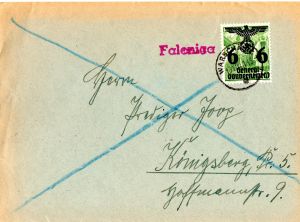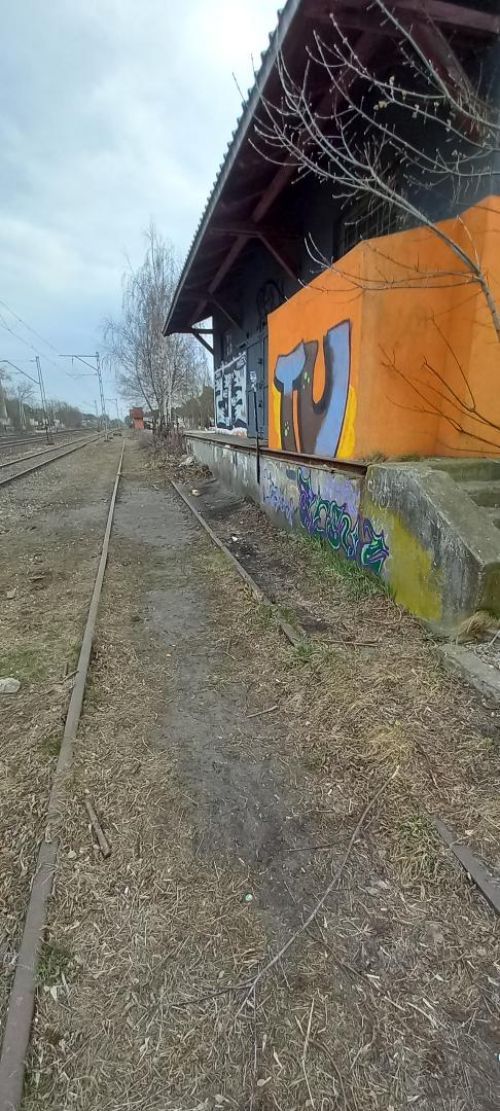Falenica

Envelope from Falencia
Falenica is located about 10 miles southeast of the city of Warsaw and in September 1939, the Jewish population stood at about 5,300 people. On 19 September 1939, many houses and stores on the Jewish streets Handlowa and Dluga were destroyed as a result of the German onslaught. At the start of the German occupation, only Wehrmacht troops were stationed in Falenica, later on some SS troops arrived to replace units sent to France. The SS commander organised a group of ethnic Germans (Volksdeutsche) from Falenica, who posed a real threat as they knew the Jewish inhabitants. In December 1939, the German authorities demanded a ‘contribution’ of 80,000 zloty on Falenica from both the Polish and Jewish inhabitants. A number of Jews forcibly evacuated from territories annexed to the Third Reich increased the population from 5,106 in 1940, to 6,500 by August 1941.
Probably in December 1939, the Jewish Council (Judenrat) was established, around the same time a Judenrat was established in nearby Otwock. Some correspondence between the Judenrat and the American Jewish Joint Distribution Committee (AJDC) in January 1940, has survived. The first head of the Judenrat was H. Cukerman, an assimilated Jew. After a few weeks the members of the Judenrat were arrested and shot, following a denunciation by the Volksdeutsche Buchholz. Then the German authorities appointed Eliasz Finkiel as the head of the Judenrat. Finkiel was already a member of the Judenrat and served on the committee for social assistance. Finkiel was a wealthy Jew from Warsaw and he owned a farm in Miedzeszyn, which is some 1.3 miles from Falenica. Performing the roles of Secretary within the Judenrat were Mieczyslaw Chodzko from Lodz and H. Szancer. In 1940, other members of the Judenrat included David Goldberg, Pinkus Rozenberg, and Majer Rajner. Later on Szancer became the head of the Judenrat in 1942, although the precise date is unknown. In Falenica the commander of the Jewish Police and the majority of the policemen were originally from Lodz. The Jewish Police also included some Jews who had been expelled from Germany in the autumn of 1938 and who had settled in Falenica. The commander of the Jewish Police was Sziker. The size of the Jewish Police force varied, but it was usually between 15 and 20 men. In the spring of 1942, Zimnawoda, a man who had also arrived from Lodz was appointed as commander of the Jewish Police, whilst Sziker became his deputy. Under this new leadership the Jewish Police became more brutal in rounding people up for forced labour, as the Germans promised to spare the families of ghetto policemen, if they delivered the required quota of workers.
On 31 October 1940, the Germans organised a ghetto in Falenica and in terms of its organisational structure, the Medem sanatorium for children in Miedzeszyn was also subordinated to the ghetto in Falenica. About 200 Jewish children resided there. Jews from Dobre, Kaluszyn, Wyszkow, and Miedzeszyn lived in the Falenica ghetto. The Jews from Wiazowna were also forced to move into the Falenica ghetto, as Wiazowna had too few Jewish inhabitants. In total, some 6,500 Jews lived in the ghetto, whilst approximately 1,500 died from hunger and disease throughout its existence. The area of the ghetto in Falenica was confined by Lawinowa, Mszanska, Chryzantemy, Hiacyntowa, and Bartoszycka Streets and also segments of Bystrzycka, Walcownicza and Patriotow Streets on one side of the railway, excluding the power station. In Miedzeszyn, the ghetto was located on the left side of the railway on the grounds of the Medem sanatorium. The ghetto was secured by a 2-meter high barbed-wire fence, although it was only fenced on the side of the road and along the railway lines; the road through the forest to Radosc remained open. The Polish (Blue) Police guarded the ghetto on the outside, whilst Jewish Police also guarded the gates on the inside. German SS troops stationed in Falenica appeared sporadically, often shot Jews who attracted their attention. The establishment of the ghetto did little to disturb the ongoing trade between Jews and Poles. To facilitate better trading opportunities the Jews took down the barbed-wire in some places and it was never repaired. The Polish policemen tolerated this trade. Poles who had been expelled from their houses went to examine their properties within the ghetto and some people even took a shortcut to the railway station in Miedzeszyn through the ghetto. Wheat was smuggled into the Falenica ghetto on a regular basis and a significant amount of the bread baked in the ghetto was sent to the Warsaw ghetto.

Falenica - Goods Station 2022 (Howard de Lestre)
During March 1940, due to the increasing number of people infected with typhus, the Judenrat was forced to establish a quarantine premises. On 10 January 1941, the Falenica ghetto was sealed off, so that Jews could no longer enter or leave, although the Germans forcibly expelled Jews from a number of locations such as Dobre, Kaluszyn, Wyszkow and Mrozy. From time to time Jews from big cities such as Warsaw and Lodz also arrived in Falenica. In the summer of 1940, Jews from the Falenica ghetto were sent to work unloading coal from trains, serving the German military forces, cleaning the streets, and doing the laundry. Jews from the ghetto were sent to forced labour in the forests, digging up tree roots, and Jews were also sent to Jozefow, near Lublin and also at the Karczew labour camps. In May 1941more than half of the 6,500 residents of the ghetto were receiving social welfare. In 1941, the Judenrat opened a hospital for the contagiously sick on the orders of the Kreishauptmann Dr. Hermann Rupprecht. In January and February 1942, the death rate in the ghetto was double that recorded in December. In January 1942 alone, some 2 percent of the total ghetto population died – the main cause of death was extreme exhaustion caused by hunger and frost.At the end of 1941, the Germans established a labour camp in Falenica for work at the sawmill and construction work at Podkowa Street on water and drainage projects, some 400 Jews worked at this camp. When the Germans started to build the Treblinka death camp and also a labour camp in Wilanow during April 1942, for the first time the Jewish Police organised round-ups for work. Some 50 people were sent to Treblinka and 70 to Wilanow. Some of the Jewish policemen were sent to watch over the workers at Wilanow, their commander was the popular German Jew, Herman Kirschrot. At the end of May 1942, the head of the Arbeitsamt (Labour office) in Otwock, Dietz and Hartlof, the administrator of the confiscated Najwer sawmill, in Falenica, arrived in the ghetto and selected between 80 -100 men for work in the sawmill and for building huts for the military. The men selected were promised they would be spared if they performed their work well. The sawmill was located outside the ghetto, and every day the Jewish police escorted the workers to the site. During August 1942, Hartlof told the workers that the ghetto would be liquidated, and he issued them work certificates (Arbeitsscheine) to protect them from deportation, a little while earlier the Polish Blue police were replaced by Ukrainian and Lithuanian units who guarded the ghetto. On 17 August 1942, Jews from the small remnant ghettos or labour camps in Milosna, Zakret, and Wiazowna were brought to Falenica. That same day the Gendarmes from Rembertow demanded 100,000 zloty to leave the ghetto, which they received.

Judenrat Notice
The liquidation of the Falenica ghetto took place on 20 August 1942, the ‘Aktion Reinhardt’ deportation squad from Warsaw, arrived to manage the deportation ‘Aktion.’ SS units and Polish Blue police surrounded the ghetto, at 4 in the morning, whilst Ukrainian and Lithuanian rounded up the people from their homes. They murdered everyone who was not able to walk or who refused to leave their homes. There were some cases of resistance whilst other Jews committed suicide. On the same day, the Jews from Rembertow were rounded up and chased on foot to Falenica. These Jews arrived around 2 p.m. though many were killed on the way. Between Miedzeszyn and Falenica, some 200 people were killed and subsequently buried in two mass graves. All the people were gathered between the synagogue and the railway tracks, approximately 150 children from the Medem sanatorium joined the transport with their teacher. After loading up, the cattle cars travelled onto Otwock to pick up the rest of the Jews, who had been caught whilst in Otwock, following the liquidation of the Otwock ghetto the previous day. Some 7,000 Jews were deported to the Treblinka death camp, where death in the gas chambers awaited them. The Germans ordered the owner of the sawmill, Najwer, to select 100 men to remain working for him. On 7 May 1943, the commander of the German Gendarmerie in Rembertow, Luppschau, along with Gendarmes from Rembertow and Otwock murdered all the workers by throwing grenades among them and then shooting the remainder. The victims were buried in a mass grave behind the sawmill. Only thirty Jews from Falenica survived the war.
Sources:
The Encyclopaedia of Camps and Ghettos 1933-1945, USHMM,
Abraham Lewin - A Cup of Tears – A Diary of the Warsaw Ghetto. Fontana Paperbacks, London 1990
Y. Arad, Belzec, Sobibor, Treblinka – The Aktion Reinhard Death Camps, Indiana University Press, Bloomington and Indianapolis 1987
Thanks to Lukasz Biedka
Photograph Chris Webb Archives, Howard de Lestre
Document - Centralna Biblioteka Judaistyczna - (ZIH) Waraaw, Poland
© Holocaust Historical Society April 9, 2022

